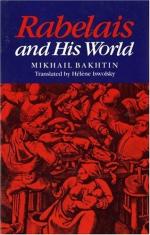
|
| Name: _________________________ | Period: ___________________ |
This test consists of 5 short answer questions, 10 short essay questions, and 1 (of 3) essay topics.
Short Answer Questions
1. What does Panurge fear if he gets married?
2. What significant thing did translators of Rabelais' work add to their translations?
3. What do wine and oil symbolize in Rabelais' novel?
4. Goethe traces the roots of Carnival to the:
5. How does Friar John interpret the riddle he and Gargantua hear?
Short Essay Questions
1. How is "folly" ambivalent?
2. Which elements of Villon and Tappecoue's (Ticklepecker's) episode make it a "tragic farce"?
3. How does Rabelais strengthen the exaggerated themes of his grotesque realism?
4. What is the significance of the figure of the androgyne in Rabelais' novel?
5. What is the significance of Friar John's description of the monastery belfry as "fecund"?
6. What is the nature of the carnivalesque crowd in Rabelais' novel?
7. How does Rabelais respond to the geographical changes of his own time and world?
8. What is the significance of the two Russian eras of history to which Bakhtin refers in Chapter Three?
9. What is significant about the language in which Rabelais writes and the sources of many of his words?
10. What was "prandial libertinism"?
Essay Topics
Write an essay for ONE of the following topics:
Essay Topic 1
How does Rabelais use myth in his work? What types of myth does he draw from (classical, popular, spiritual, etc.)? How are allusions to mythology a part of carnivalesque culture? Cite at least three specific examples of identifiable myths which Rabelais alludes to, alters, parodies, travesties, or repeats.
Essay Topic 2
Explain how laughter permeates every aspect of Renaissance folk culture, as Bakhtin argues it does. Cite specific examples from the text regarding the carnivalesque, the grotesque, official/unofficial modes of speech, and the ambivalence of certain forms and causes of laughter. Do these portrayals point to a greater "truth," as Bakhtin would say?
Essay Topic 3
Examine the structure, the presence, and the purpose of the Foreword and the Prologue. What do they offer to the reader? What is the purpose of a foreword or a prologue--what is the function of writing an introduction to someone else's book? Can, or do, such prefatory remarks influence the reader's experience of the text? Can reading ever be a "pure" activity with no outside influence of opinion?
|
This section contains 1,029 words (approx. 4 pages at 300 words per page) |

|




